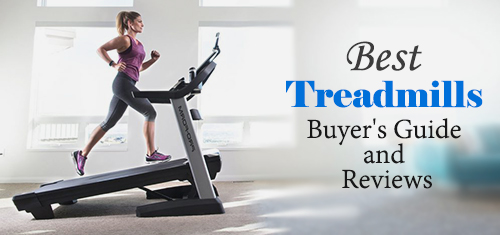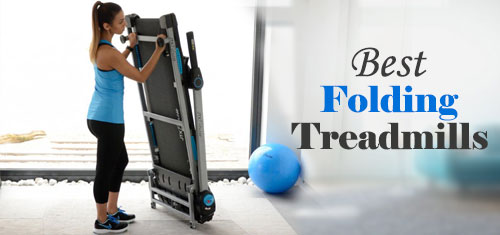- Home
- HIIT Workout
HIIT Workouts for Treadmill

HIIT stands for High-Intensity Interval Training and it is a cardiovascular based strategy that emphasizes short and intense anaerobic exercises with fewer recovery periods jacking the heart rate up.
You won’t need 2 to 3 hours of work just to attain the body that you desire. 30 to 45 minutes of brisk intensity training and you will get the benefits of it rather quickly. It trains both your mind and your body to be disciplined and determined to be better.
Although high-intensity intervals speed up your heart rate, HIIT can decrease strain on your heart. Over time, cardiovascular exercise can increase your heart stroke volume or the amount of blood that your heart pumps per beat.
HIIT additionally maximizes the opposite advantages of vas exercise, including decreasing your risk of both heart disease and high blood pressure.
Before you learn about HIIT workouts for treadmill, let’s learn some more about HIIT.
Table of Content:
How Does HIIT Works?
During your intense period of activity, your interval training highlights the aerobic and anaerobic systems. The anaerobic system metabolizes energy stored in the muscles which are glycogens for short bursts of movements without needing energy.
The lactic acid then builds up as a result of the person's experience of oxygen deprivation. The body then is allowed to have a recovering period with the heart and lungs to work giving back oxygen and breaking down the lactic acid.
The aerobic system then takes over using the oxygen to convert stored carbohydrates into energy. Thus reducing the stored amount of fat and utilizing it as a stock tank needed for your workout.
This training has a wide range of variety towards its timescales and repetitions to be programmed by your coach. But it enables you to have greater exposure towards intense and difficult training without excess fatigue. It forces the person to activate the body’s adaptation response which caveman use centuries ago.
The combination of the cardiovascular system with muscle endurance can significantly improve an athlete's performance and well-being. By taking in great amounts of oxygen with the right physical activity that we coach take into account, we can strengthen the heart muscles and build a fun workout without the strain of injuries and breaking of mental fortitude in a program.
The Central Nervous System(CNS) is primarily affected by this high-intensity work and takes a minimum of 48 hours to recover. If you are overtraining, intervals will tax your system and cause muscle injury, mechanical tension, and metabolic stress.
Like lifting heavy iron, interval training must be allotted sufficient recovery time that is why great programming is to be focused on so that both the athlete and client as well as the coach achieve their goals.
Getting Started with Interval Training
Before you start an exercise program that involves high-intensity activity, you need to be sure that you are healthy enough for vigorous activity. You’ll be working very hard, so check with your doctor to be sure that you are in good health.
Next, you wish to incorporate your interval exercise program in a very well-designed exercise schedule. That means you should be well-rested going into the workout and you’ll need a recovery day (not a rest day!) afterward.
Never do back-to-back HIIT workouts to lose weight. Believe it or not, this might ruin the entire weight loss exertion plan less effective.
How to do High Intensity Interval Training (HIIT) on a Treadmill
Using a treadmill is very common in the fitness industry, it is widely utilized on people who don't have enough time to go out to the park and exercise. RPE stands for Rate of Perceived Exertion, and you can find it indicated on your tread.
On a scale of zero to ten, think of 0 as an effort equivalent to relaxing on the couch, 5 a recovery jog that’s easy enough for you to talk, and 10 your all-out sprint.
Here are 5 HIIT workouts to spice up your treadmill routine:
1. Basic Treadmill Workout
- Warm-up with a brisk walk and work your way up to a light jog – 10 minutes
- Run at ten mph for thirty seconds to one minute
- Walk at 3.5-4 mph for 2 minutes
- Repeat this cycle seven a lot of times (8 cycles total)
- Complete work out with a cool-down walk for 5 minutes
2. Steady Paced Workout
- 5-min warm-up at a brisk walk pace
- Run one minute at 7 mph followed by a pair of minutes at five. 5 mph - repeat 5 times (15 minutes)
- Walk one minute at a straightforward pace to recover a touch
- Run thirty seconds at 10-12 mph followed by 1 minute at 4 mph - repeat five times (7.5 minutes)
- 4-minute cool down walk
3. Endeavor Rate Workout
- 0:00-5:00: Start walking or jogging at an RPE 5, gradually increasing the incline (without increasing your speed), so that by the end of the first five minutes, you’re at an RPE 6
- 5:00-7:00: Increase your speed and maintain the incline, working at an RPE 7
- 7:00-9:00: Increase the incline and maintain your speed, working at an RPE 8
- 9:00-12:00: Reduce your speed, but maintain the incline, working at an RPE 7
- 12:00-15:00: Increase your speed and if possible, increase the incline. These are your last 3 minutes of toil, so push it! Try to work up to an RPE 9
- 15:00-20:00: step by step cut back your speed and incline - by the last minute of your routine you must be back to an RPE four or five
4. Stiff-Legged Workout
- 0:00-2:00: 6 mph, Incline 1%
- 2:00-6:00: Alternate thirty seconds at 10 mph and three inclines with thirty seconds at 4 mph and three incline
- 6:00-8:00: 6 mph, Incline 1%
- 8:00-12:00: Alternate thirty seconds at 10 mph and four-dimensional incline with thirty seconds at 4 mph and four-dimensional incline
- 12:00-14:00: 6 mph, Incline 1%
- 14:00-18:00: Alternate thirty seconds at 10 mph and three inclines with thirty seconds at 4 mph and three incline
- 18:00-20:00: 6 mph, Incline 1%
- 20:00-22:00: 4 mph, Incline 1%
5. Swift Workout
- 5 minutes: Warm-up (dynamic stretches, walk or jog)
- 30 seconds: Strides (RPE 6+)
- 30 seconds: Recovery walk or jog (RPE 6)
- 30 seconds: Strides (RPE 6+)
- 30 seconds: Recovery walk or jog (RPE 6)
- 1 minute: Jog at four % incline (RPE 7)
- 1 minute: Flat road recovery (RPE 6)
- 2 minutes: Hard run (RPE 8–9)
- 1 minute: Recovery walk or jog (RPE 4–5)
- 1 minute: Hard run (RPE 8+)
- 30 seconds: Sprint (RPE 10)
- 2 minutes: Cool down (walk or jog)
What is the Best HIIT exercise?
There are no best HIIT exercises. Every movement can be used greatly when applied with the system HIIT has offered. Doing 100 push-ups every single day may not be suitable for someone who has a lot of work to do in their job.
With HIIT you can incorporate like a TABATA which is 20 seconds of work then 10 seconds of rest for 8 rounds and get the same stimulus with greater benefits with just straight up 100. It will only take you 4 minutes to do the workout and achieve your goal!
HIIT Workouts for Beginners
- Complete 5 Circuits with 30 secs rest in Between
- Burpees - 20 secs
- Jumping Jacks - 20 secs
- Squats - 20 secs
- Raise Arm Circles - 20 secs
- High Knees - 20 secs
- Tabata (20 secs on/10 secs off)
- Hollow Hold
- Flutter Kicks
- Arch Hold
- Scissors
How to Do Interval Running?
Instead of a regular jog or run in a treadmill, you can use interval training to up your game! Having shorter recovery periods can boost your overall fitness level.
Here are examples of Interval Running:
- Walking/Jogging
Jog or walk at a more comfortable pace for three minutes. Sprint for 60 seconds. Perform 5 to 10 cycles or continue till you've got completed 2 or 3 miles. Total exercising time can rely on your fitness level and running speed.
- Hill Repeats
Complete eight to ten repeats. (Do more if the hill is short and fewer if the hill is long.) Rest for two to three minutes, then go for one or two more rounds.
Is HIIT Good For Losing Weight?
According to a Tedx speaker Ruben Meerman, only 16% of fat is being released by the body through sweat, urine or in waste manner. 84% fat gets let out through breathing that is why when you do physical exercises or activities you tend to lose weight than just sitting on your desk and using your computers all day long.
Moving our bodies is essential in many ways. Physical exercises are good for muscles and bones. Our body is like a machine that needs to be well-oiled and maintained so that it will have a longer timespan for you to use. This prevents you from buying a new one or replacing parts that will cost you a lot of money.
Health is also similar to this and we shouldn’t forget that we only have one body and if that breaks, its game over for you. HIIT is a very effective way to lose weight at the same time reap great benefits in your fitness level.
What are the Benefits of HIIT?
In terms of weight loss, intervals are simpler than long, slow endurance exercise. The intense effort you set in implies that your body should work more durable to recover, so you’ll burn more calories in the 24 hours after an interval workout than you would after a slow, steady run.
During those 24 hours after high-intensity interval training, your body can also produce up to 450 percent more human growth hormone, which increases caloric burn and even slows down the aging process.
Interval coaching creates a surge of endorphins, the natural opiates your brain produces as a result of difficult exercise. Because of its short bursts of strenuous activity, interval coaching drastically boosts peptide production, thus you’ll expertise a real “runners high” and can feel happy and energized when your effort.
Mistakes to Avoid When Doing HIIT?
No doubt HIIT is one amazing workout, but there are some aspects of the workout that you may be doing wrong. These mishaps could sabotage your efforts and diminish your results.
Stephanie Lincoln, a personal trainer, warns us against HIIT intervals that last longer than thirty seconds more or less. Her idea recommends that we should always stay at these intervals so you can reap the benefits.
As a Metabolic Conditioning coach, I usually do a group class and stay at the range of an hour to maintain the cycle speed of the workout format. I incorporate strength and skill training before every HIIT routine to gain hypertrophy with your body and the muscles.
My workout program doesn't go over the 15-minute mark as the body tends to slow down. The objective is to go hard and fast and push during work intervals. You’ve got a small window of time to do so before hitting fatigue or failure.
"HIIT training is a burst of effort that is powerful followed by rest periods," this is what Rob Jackson, a private trainer, explains at London-based Minimal Fit. Like running for more than a thousand kilometers, you won’t maintain your sprint record. By the time you get a thousand kilometers, your running speed would have decreased drastically.
HIIT's key essential is to keep the intensity high and let your heart pump fast which defeats the purpose cause you’ll be at a steady pace which we are not aiming for.
In conclusion, whether you are an athlete, a home-based freelancing agent or a desk job officer. No matter the line of work you are in; fitness is a necessity everyone needs to maintain. If pursuing to be at the side of your grandchildren is your goal in the future then it is best to start now and do the effort to make a change.
Struggling is a very small area for transformation. It takes discipline, willingness, and the grit to remove all excuses and handle your health and body situations. Every single day you neglect your condition, it escalates every bad habit you did from day one.
Check and compare Treadmills here before you buy any.
Check my pricing, ongoing promotions, manufacturer, mark and model, etc then make a decision.


